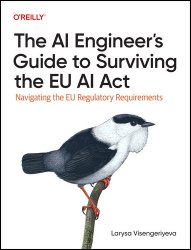 Название: The AI Engineer's Guide to Surviving the EU AI ACT: Navigating the EU Regulatory Requirements Название: The AI Engineer's Guide to Surviving the EU AI ACT: Navigating the EU Regulatory Requirements
Автор: Larysa Visengeriyeva
Издательство: O’Reilly Media, Inc.
Год: 2025
Страниц: 300
Язык: английский
Формат: epub
Размер: 10.1 MB
With the introduction of the EU AI Act, companies employing AI systems face a new set of comprehensive and stringent regulations. Dr. Larysa Visengeriyeva offers a much-needed guide for navigating these unfamiliar regulatory waters to help you meet compliance challenges with confidence.
From explaining the legislative framework to sharing strategies for implementing robust MLOps and data governance practices, this wide-ranging book shows you the way to thrive, not just survive, under the EU AI Act. It's an indispensable tool for engineers, data scientists, and policymakers engaged in or planning for AI deployments within the EU.
This book also addresses the particular challenges posed by general-purpose AI (GPAI) and generative AI (GenAI), late but significant additions to the Act. The concept of generative AI operations (GenAIOps) is introduced as an extension of traditional MLOps principles to handle the unique complexities of GPAI and generative AI applications. Applying AI engineering principles to implement transparency obligations for GPAI and integrating CRISP-ML(Q), SMACTR, and GenAIOps are crucial for navigating this evolving landscape.
By reading, you'll gain:
An in-depth understanding of the EU AI Act, including the four risk categories and what they mean for you
Strategies for compliance, including practical approaches to achieving technical readiness
Actionable advice on applying MLOps methodologies to ensure ongoing compliance
Insights on the implications of the EU's pioneering approach to AI regulation and its global effects
Who Should Read This Book:
This book is intended for AI engineers, MLOps practitioners, data scientists, AI product managers, and anyone involved in the hands-on development and deployment of AI systems. It demonstrates how, through the application of robust methodologies, disciplined documentation, and continuous integration of ethical considerations, AI teams can build systems that are not only technically innovative but also demonstrably compliant, trustworthy, and aligned with societal expectations. I have tried to make this book as actionable as possible by introducing a comprehensive framework and practical checklists for aligning AI engineering practices with the EU AI Act articles throughout the CRISP-ML(Q) lifecycle.
Скачать The AI Engineer's Guide to Surviving the EU AI ACT: Navigating the EU Regulatory Requirements
|